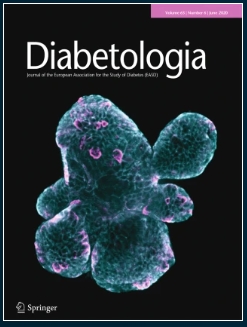Profiling associations of interactive ligand-receptors (HLA class I and KIR gene products) with the progression to type 1 diabetes among seroconverted participants.
IF 10.2
1区 医学
Q1 ENDOCRINOLOGY & METABOLISM
引用次数: 0
Abstract
AIMS/HYPOTHESIS The aim of this work was to explore associations between type 1 diabetes progression from stages 1 or 2 to stage 3 and interacting ligand-receptor complexes of HLA class I (HLA-I) and KIR gene products. METHODS Applying next-generation sequencing technology to genotype HLA-I genes (HLA-A, -B, -C) and KIR genes (KIR2DL1, KIR2DL2, KIR2DL3, KIR2DL4, KIR2DL5, KIR2DS1, KIR2DS2, KIR2DS3, KIR2DS4, KIR2DS5, KIR3DL1, KIR3DL3, KIR3DS1, KIR2DP1, KIR3DP1) from 1215 participants in the Diabetes Prevention Trial-Type 1 (DPT-1) and the Diabetes Prevention Trial (TN07), we systematically explored associations of HLA-I-KIR ligand-receptor interactions (LRIs) with disease progression via a Cox regression model. We investigated the structural properties of identified LRI complexes. RESULTS KIR and HLA-I genes had no or sporadic associations with disease progression. Out of all possible LRIs, nine HLA-A ligands and 14 HLA-B ligands with corresponding receptors had modest associations with progression (p<0.05). As an example, carriers of A*03:01-KIR2DS4 had slower progression (HR 0.36, p=3.06 × 10-2), as did B*07:02-KIR2DL3 carriers (HR 0.26, p=7.76 × 10-3). Structural investigations of KIR-HLA-I complexes via homology modelling based on already-solved respective complex structures suggested that the respective electrostatic and van der Waals interactions encoded in the protein sequences result in strong biophysical LRIs, which could alter the progression of type 1 diabetes. CONCLUSIONS/INTERPRETATION These results reveal that LRIs of KIR-HLA-I gene products, rather than individual genes, contribute to type 1 diabetes progression, and such interactions are likely to be stabilised by electrostatic and van der Waals forces. As the KIR-HLA-I interactions involve part of the C-terminus of the antigen-binding groove of HLA-I, but may be affected by the respective bound peptide, this suggests a new mechanism for type 1 diabetes pathogenesis. DATA AVAILABILITY Clinical data on participants in DPT-1 and TN07 can be obtained from the NIDDK-Central Repository ( https://repository.niddk.nih.gov/home ) following the formal approval process.相互作用配体受体(HLA I类和KIR基因产物)与血清转化参与者中1型糖尿病进展的关系分析
目的/假设本研究的目的是探讨1型糖尿病从1期或2期进展到3期与HLA-I类(HLA-I)和KIR基因产物的相互作用配体受体复合物之间的关系。方法应用新一代测序技术对1215名糖尿病预防试验1型(ddt -1)和糖尿病预防试验(TN07)参与者的HLA-I基因(HLA-A、-B、-C)和KIR基因(KIR2DL1、KIR2DL2、KIR2DL3、KIR2DL4、KIR2DL5、KIR2DS1、KIR2DS3、KIR2DS4、KIR2DS5、KIR3DL1、KIR3DL3、KIR3DS1、KIR2DP1、KIR3DP1)进行测序,通过Cox回归模型系统探讨HLA-I-KIR配体-受体相互作用(LRIs)与疾病进展的关系。我们研究了鉴定的LRI配合物的结构性质。结果skir和hla - 1基因与疾病进展无相关性或零星相关性。在所有可能的LRIs中,9个HLA-A配体和14个HLA-B配体具有相应的受体,与进展有适度的相关性(p<0.05)。例如,A*03:01-KIR2DS4携带者的进展较慢(HR 0.36, p=3.06 × 10-2), B*07:02-KIR2DL3携带者的进展较慢(HR 0.26, p=7.76 × 10-3)。基于已经解决的复合物结构,通过同源性建模对kir - hla - 1复合物的结构研究表明,编码在蛋白质序列中的各自的静电和范德华相互作用导致了强的生物物理LRIs,这可能改变1型糖尿病的进展。结论/解释这些结果揭示了kir - hla - 1基因产物的LRIs,而不是单个基因,促进了1型糖尿病的进展,这种相互作用可能通过静电和范德华力稳定。由于kir - hla - 1相互作用涉及hla - 1抗原结合槽的部分c端,但可能受到各自结合肽的影响,这提示了1型糖尿病发病的新机制。数据可用性DPT-1和TN07参与者的临床数据可在正式批准程序后从NIDDK-Central Repository (https://repository.niddk.nih.gov/home)获得。
本文章由计算机程序翻译,如有差异,请以英文原文为准。
求助全文
约1分钟内获得全文
求助全文
来源期刊

Diabetologia
医学-内分泌学与代谢
CiteScore
18.10
自引率
2.40%
发文量
193
审稿时长
1 months
期刊介绍:
Diabetologia, the authoritative journal dedicated to diabetes research, holds high visibility through society membership, libraries, and social media. As the official journal of the European Association for the Study of Diabetes, it is ranked in the top quartile of the 2019 JCR Impact Factors in the Endocrinology & Metabolism category. The journal boasts dedicated and expert editorial teams committed to supporting authors throughout the peer review process.
 求助内容:
求助内容: 应助结果提醒方式:
应助结果提醒方式:


